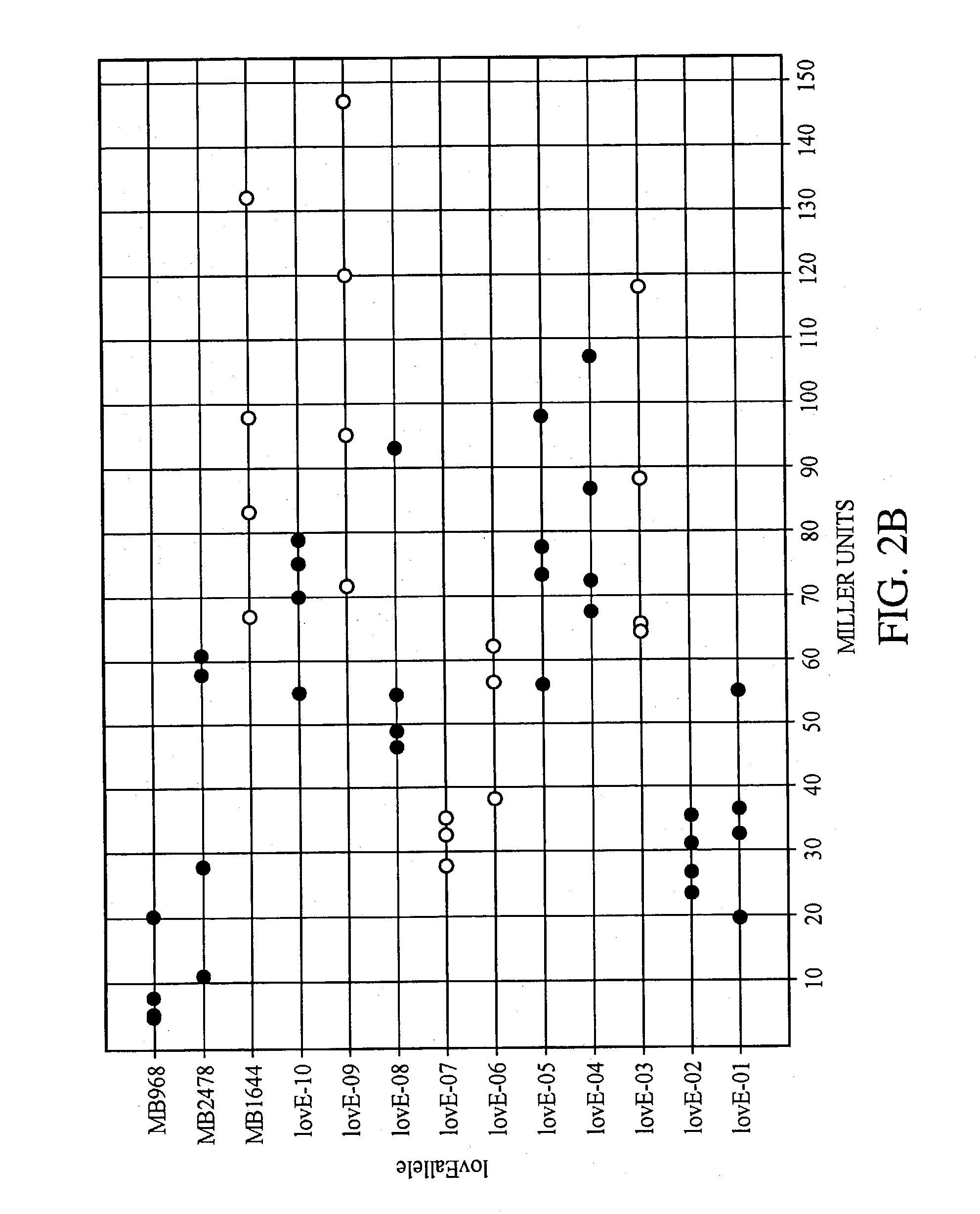lovE variant regulator molecules
a variant regulator and molecule technology, applied in the field of love variant regulator molecules, can solve the problems of not being useful as a source for the isolation of naturally occurring mutant alleles, the method of culture or fermentation also affects directly the amount of secondary metabolites produced, and the problem of frequent exacerbated problems
- Summary
- Abstract
- Description
- Claims
- Application Information
AI Technical Summary
Benefits of technology
Problems solved by technology
Method used
Image
Examples
example 1
[0109] Preparation of Strains and Plasmids
[0110] Strain MY2124 was derived from the Sigma 1278b strain background of S. cerevisiae and its complete genotype is as follows: MAT.alpha. / MAT.alpha.:LEU2 ura3 .DELTA.0 / ura3.alpha.0 leu2 .DELTA.0 / leu2 .DELTA.0 trp1 .DELTA.0::hisG / trp1 .DELTA.0::hisG his3 .DELTA.0::hisG / his3 .DELTA.0::hisG ura3 .DELTA.0::lovF-HIS3p-neo / ura3 .DELTA.0. MY2124 can be constructed by mating S. cerevisiae strains MY2112 (MAT.alpha. ura3 .DELTA.0 leu2 .DELTA.0 trp1 .DELTA.0::hisG his3 .DELTA.0::hisG ura3 .DELTA.0::lovFp-HIS3p-neo) with MY1555 (mat.alpha.::LEU2 ura3 .DELTA.0 leu2 .DELTA.0 trp1 .DELTA.0::hisG his3 .DELTA.0::hisG) and isolating zygotes. The ura3 .DELTA.0::lovFp-HIS3p-neo allele of MY2112 was derived by cotransforming SfiI-linearized plasmid MB2254 with pRS424 (Sikorski and Hieter (1989) Genetics 122:19-27) into MY1413 (MAT.alpha. leu2 .DELTA.0 trp1 .DELTA.0::hisG his3 .DELTA.0::hisG). Transformants were selected on SC-Trp media and subsequently scree...
example 2
[0119] PCR Mutagenesis of the lovE DNA Binding Domain
[0120] The zinc finger DNA binding domain of lovE is encoded by nucleotides 100-201 (SEQ ID NO: 92). Oligos MO2624 (SEQ ID NO: 18) and MO2654 (SEQ ID NO: 19) were used to PCR amplify a lovE containing fragment from plasmid MB2478. The 1.7 kb product contains nucleotides 212-1410 of lovE and .about.500 bp of flanking vector sequence. Two rounds of standard PCR (1.5 mM MgCl.sub.2) were performed with Amplitaq DNA polymerase (Applied Biosystems, Foster City, Calif.) according to the manufacturer's instructions.
[0121] Plasmid MB2848 was cut with KpnI-BamHI to release a 1.1 kb fragment containing the At274 portion of the lovE-At274 chimeric open reading frame. The remaining 5.5 kb vector sequence retains the lovE DNA binding domain.
example 3
[0122] PCR Mutagenesis of the lovE Open Reading Frame
[0123] lovE open reading frame insert was prepared according to the following procedure. Oligo pairs MO2680 (SEQ ID NO: 20) / MO2686 (SEQ ID NO: 21), MO2681 (SEQ ID NO: 22) / MO2686, and MO2700 (SEQ ID NO: 23) / MO2701 (SEQ ID NO: 24) were used to PCR amplify the entire lovE open reading frame from plasmid MB2478. The PCR products differ in the amount of 5' and 3' vector sequence flanking the lovE open reading frame.
[0124] PCR was performed using a GeneMorph PCR mutagenesis kit (Stratagene, La Jolla, Calif.) according to manufacturer's instructions to achieve medium and high range mutation frequencies.
[0125] Plasmid MB2478 was cut with Asp718 / XbaI to release a 1.7 kb fragment. The remaining 5.0 kb vector sequence completely lacks lovE ORF sequence.
PUM
 Login to View More
Login to View More Abstract
Description
Claims
Application Information
 Login to View More
Login to View More - R&D
- Intellectual Property
- Life Sciences
- Materials
- Tech Scout
- Unparalleled Data Quality
- Higher Quality Content
- 60% Fewer Hallucinations
Browse by: Latest US Patents, China's latest patents, Technical Efficacy Thesaurus, Application Domain, Technology Topic, Popular Technical Reports.
© 2025 PatSnap. All rights reserved.Legal|Privacy policy|Modern Slavery Act Transparency Statement|Sitemap|About US| Contact US: help@patsnap.com



